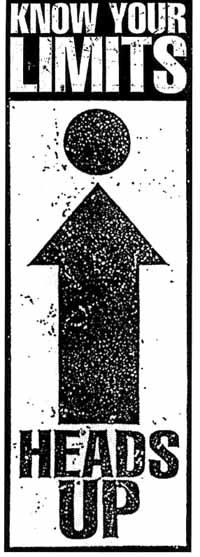Baldy’s record is safer than most
Injury-prone skiers are "usually better-than-average skiers who
are skiing at high rates of speed on the margins of intermediate trails."
Tim White, National Ski Areas Association education director
By GREG STAHL
Express Staff Writer
 This graphic, designed by the National Ski Areas
Association (NSAA), encourages skiers and snowboarders to ski carefully within their
abilities. The logo is an offshoot from a 2000 ski safety campaign.
This graphic, designed by the National Ski Areas
Association (NSAA), encourages skiers and snowboarders to ski carefully within their
abilities. The logo is an offshoot from a 2000 ski safety campaign.
Skiing is an inherently hazardous sport, but among U.S. ski areas, Sun
Valley’s safe record stands out.
"This mountain is much safer to ski than other mountains," Sun
Valley ski patrol director Bruce Malone said in a Friday interview.
His comment came two days after a harrowing accident on Bald Mountain in
which two skiers were almost killed in a collision.
Numbers compiled by the Sun Valley ski patrol and the National Ski Areas
Association (NSAA) back his assertion.
Compared with the average number of ski patrol medical calls logged on
U.S. ski mountains each year, Sun Valley is considerably lower than average.
Last year, the Sun Valley ski patrol responded to 1.55 medical calls for
every 1,000 skier visits. The 10-year national average is 2.5, Denver-based National Ski
Areas Association (NSAA) education director Tim White said Friday.
Malone said Sun Valley usually scores in the 1.55 range.
"We’re very proud of that," he said.
He pointed out that, of those calls, only one-third usually lead to
further, off-mountain medical treatment.
Malone speculated that Sun Valley is probably safer than most ski areas
because of Baldy’s consistent pitch.
"If [skiers and snowboarders] can’t finish their turns, they
don’t make it very far here," he said of the control necessary to ski on Bald
Mountain.
Also, Malone said, Baldy’s traffic patterns are conducive to safe
skiing. Trails tend to funnel skiers in the same direction, rather than intersecting each
other as they do at some ski areas.
And ski accidents aren’t the leading cause of on-slope deaths on Bald
Mountain. Heart attacks are.
According to Ketchum Ranger District recreation manager David Gordon, nine
skiers or snowboarders have died on Baldy since 1986, and, of those, six were caused by
heart attacks. One other may have been caused by a heart attack.
And Malone said most accidents are not the result of collisions.
"Collisions are more rare but more serious," he said.
White said there are several common ingredients to most serious ski
accidents. Most occur when a skier is on a trail below his or her ability level; most
accident victims are male; and most are young (18 to 30). Speed, White said, is also
typically part of the critical equation.
Injury-prone skiers are "usually better-than-average skiers who are
skiing at high rates of speed on the margins of intermediate trails," White said.
That most injury-prone age group is the same population, confirms the NSP,
that suffers the majority of all deaths from all accidents in the United States.
White and Malone pointed out that, overall, skier injuries have fallen in
the past 15 years due to improvements in binding and boot technologies.
According to the National Ski Patrol’s (NSP’s) Web site, the
majority of ski and snowboard related accidents now involve knee or upper body injuries.
"Our fear is that there’s a growing perception that skiing is
becoming more dangerous," White said. "The fact is, injuries are reducing."
The overall rate of reported injuries industry-wide has declined by 50
percent during the past 25 years, according to the NSP’s Web site.
Broken lower legs have decreased more than 95 percent since the early
1970s.